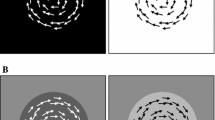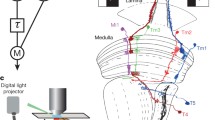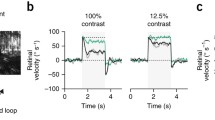Abstract
The time constant of movement detectors in the fly visual system has been proposed to adapt in response to moving stimuli (de Ruyter van Steveninck et al. 1986). The objective of the present study is to analyse, whether this adaptation can be induced as well, if the luminance of a stationary uniform field is modulated in time. The experiments were done on motion-sensitive wide-field neurones of the lobula plate, the posterior part of the third visual ganglion of the blowfly, calliphora erythrocephala. These cells are assumed to receive input from large retinotopic arrays of movement detectors. In order to demonstrate that our results concern the properties of the movement detectors rather than those of a particular wide-field cell we recorded from two different types of them, the H1- and the HSE-cell. Both cell types respond to a brief movement stimulus in their preferred direction with a transient excitation. This response decays about exponentially. The time constant of this decay reflects, in a first approximation, the time constant of the presynaptic movement detectors. It was determined after prestimulation of the cell by the following stimuli: (a) periodic stationary grating; (b) uniform field, the intensity of which was modulated sinusoidally in time (flicker stimulation); (c) periodic grating moving front-to-back; (d) periodic grating moving back-to-front. The decay of the response is significantly faster not only after movement but also after flicker stimulation as compared with pre-stimulation with a stationary stimulus. This is interpreted as an adaptation of the movement detector's time constant. The finding that flicker stimulation also leads to an adaptation shows that movement is not necessary for this process. Instead the adaptation of the time constant appears to be governed mainly by the temporal modulation (i.e., contrast frequency) of the signal in each visual channel.
Similar content being viewed by others
References
Borst A, Bahde S (1987) Comparison between the movement detection systems underlying the optomotor and the landing response in flies. Biol Cybern 56:217
Buchner E (1984) Behavioural analysis of spatial vision in insects. In: Ali MA (ed) Photoreception and vision in invertebrates. Plenum Press, New York London, pp 561–621
Egelhaaf M, Reichardt W (1987) Dynamic response properties of movement detectors: Theoretical analysis and electrophysiological investigation in the visual system of the fly. Biol Cybern (in press)
Götz KG (1965) Behavioral analysis of the visual system of the fruitfly Drosophila. Proceedings of the symposium on information processing in sight sensory systems. Cal Tech, California Pasadena, pp 85–100
Götz KG (1972) Principles of optomotor reactions in insects. Bibl Ophthal 82:251–259
Hausen K (1981) Monocular and binocular computation of motion in the lobula plate of the fly. Verh Dtsch Zool Ges 74:49–70
Hausen K (1982a) Motion sensitive interneurons in the optomotor system of the fly. I. The horizontal cells: structure and signals. Biol Cybern 46:67–79
Hausen K (1982b) Motion sensitive interneurons in the optomotor system of the fly. II. The horizontal cells: receptive field organization and response characteristics. Biol Cybern 45:143–156
Howard J, Dubs A, Payne R (1984) The dynamics of phototransduction in insects. J Comp Physiol 154:707–718
Maddess T, Laughlin SB (1985) Adaptation of the motion-sensitive neuron H1 is generated locally and governed by contrast frequency. Proc R Soc London Ser B 225:251–275
Reichardt W (1961) Autocorrelation, a principle for the evaluation of sensory information by the central nervous system. In: Rosenblith WA (ed) Sensory communication. MIT Press and Wiley, New York London, pp 303–317
Ruyter van Steveninck RR de, Zaagman WH, Mastebroek HAK (1986) Adaptation of transient responses of a movement-sensitive neuron in the visual system of the blowfly Calliphora erythrocephala. Biol Cybern 53:451–463
Author information
Authors and Affiliations
Rights and permissions
About this article
Cite this article
Borst, A., Egelhaaf, M. Temporal modulation of luminance adapts time constant of fly movement detectors. Biol. Cybern. 56, 209–215 (1987). https://doi.org/10.1007/BF00365215
Received:
Issue Date:
DOI: https://doi.org/10.1007/BF00365215




